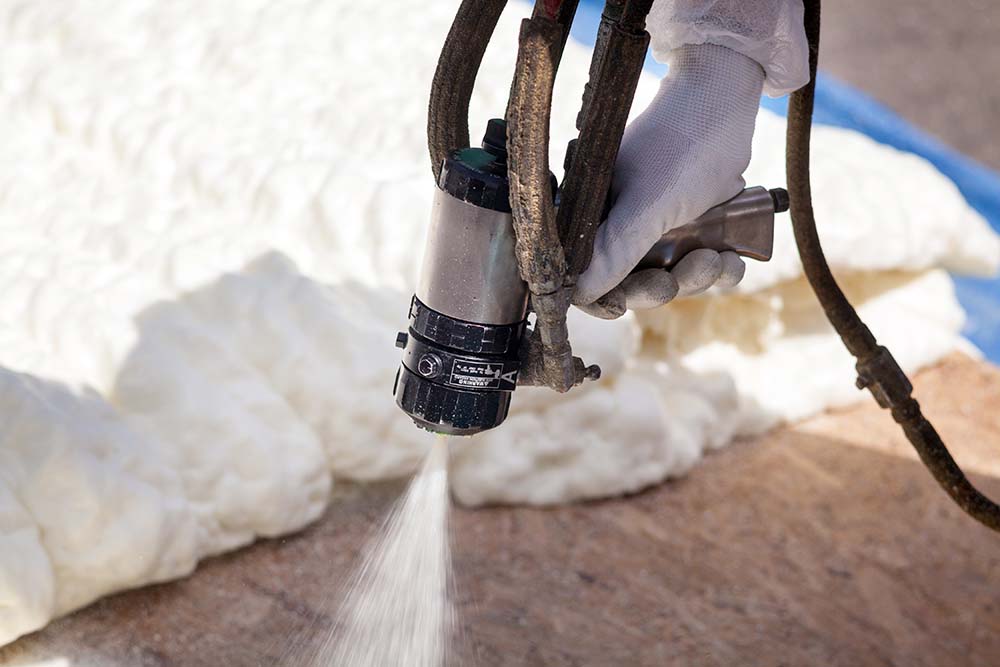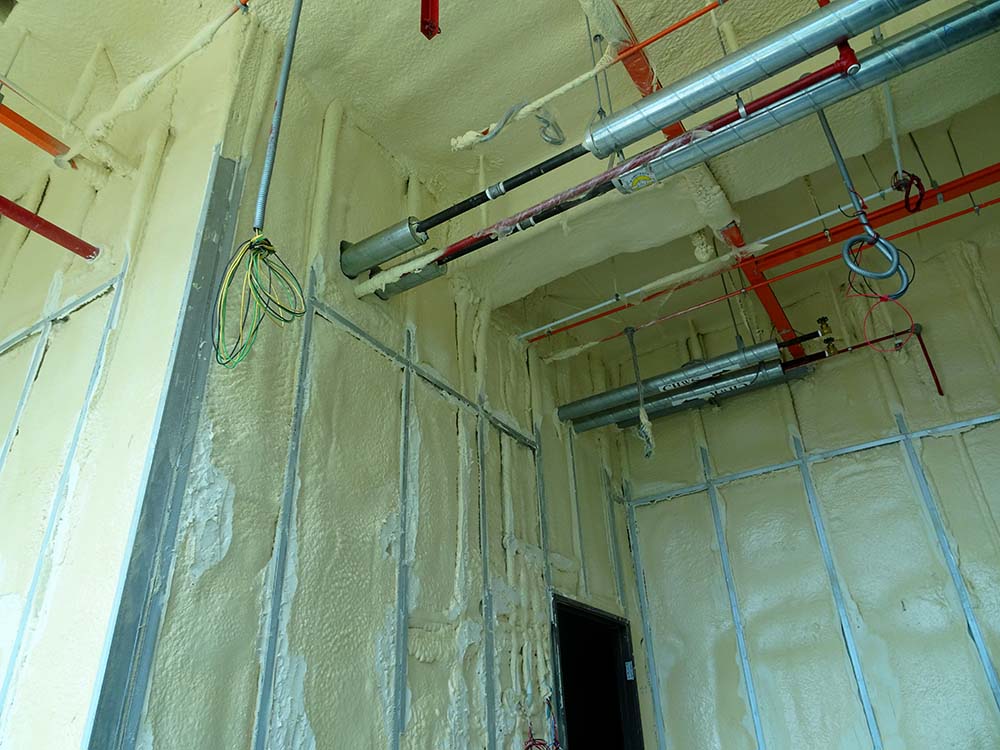Transform Your Home With Spray Foam Insulation
Our insulation services will improve your comfort and energy efficiency.
Improve Your Home's Insulation With Spray Foam
Say goodbye to home insulation issues and welcome a more energy-efficient and comfortable living space with our spray foam insulation services. Whether you need to enhance the insulation level or replace ineffective insulation, we have the solution.
Uninsulated areas in your attic, basement, crawl space, or garage can be easily addressed with our advanced polyurethane spray foam insulation. By installing this cutting-edge material, we ensure your home achieves optimal insulation for superior energy efficiency and precise temperature control.
Why Choose Spray Foam for Your Home Insulation Needs?
Spray foam insulation is the ideal choice for filling open wall cavities and insulating unfinished attics. Using a heated hose, we pressure-spray the insulating foam into targeted areas, where it adheres to inner wall surfaces and expands, effectively filling the space and trapping gas bubbles within the foam.
We meticulously spray the polyurethane foam into the wall space, creating a thick and even layer until it reaches the desired R-value, tailored to suit the climate of the specific area of your home is insulated. This ensures maximum thermal insulation capability and guarantees exceptional performance.

Discover the Advantages of Spray Foam Insulation
Spray foam insulation offers numerous benefits that will your home’s energy efficiency and comfort during the winter and summer. Here are just a few advantages of choosing our expandable foam insulation:
Eliminates drafts: Say goodbye to chilly winter drafts and keep the summer heat at bay, enjoying a consistently comfortable indoor environment throughout the year.
Energy efficiency: By preventing conditioned air from escaping and sealing out unwanted outdoor air, our spray foam insulation helps reduce energy consumption and lowers your utility bills.
Moisture protection: With its exceptional sealing properties, our insulation creates a barrier against moisture infiltration, safeguarding your home from potential damage and the growth of mold and mildew.
Structural integrity: By preventing wood rot and other threats, our insulation contributes to the long-term stability and durability of your home, protecting your investment.
Cost savings: Lower energy bills combined with reduced maintenance and repair costs translate into significant savings over time, making our spray foam insulation a smart investment for any homeowner.
Consistent indoor temperature: Enjoy a comfortable and consistent indoor temperature throughout your home, with no more hot or cold spots, as our insulation ensures a well-balanced climate in every room.

What Is Spray Foam Insulation?
Spray foam insulation is highly effective in sealing gaps, ensuring superior insulation and preventing energy waste.

How Is Spray Foam Applied?
One great advantage of spray foam insulation is its application onto multiple types of surfaces including wood, brick, and stone.
The Power of Polyurethane Foam
Spray foam insulation is made from high-quality polyurethane foam, available in open cell and closed cell varieties, each with its unique density. Both options offer exceptional insulation and air sealing qualities, as well as protection against moisture, noise, and pests. With spray foam insulation, you unlock a multitude of benefits, including financial savings, improved health, enhanced building efficiency, and a greener environment.

Spray Foam Offers Unparalleled Benefits
Outperforming all other insulation types, spray foam insulation delivers long-term benefits that far outweigh its initial installation costs. Unlike fiberglass that can flatten over time, spray foam insulation stays in place, ensuring consistent performance and long-lasting value. With superior sealing properties, it creates an airtight barrier and contributes to a healthier, more comfortable living space.
Unmatched Protection and Efficiency
Spray foam goes beyond the limitations of traditional insulation. While fiberglass can only protect against heating and cooling loss caused by conduction, our spray foam tackles six paths of energy loss. It safeguards against conduction, convection, radiation, air infiltration, moisture accumulation, and air intrusion.
An Environmentally Friendly Choice
When you choose spray foam, you’re making an environmentally conscious decision. Spray foam does not retain moisture or foster mold and mildew growth, safeguarding walls, and attics from long-term damage and reducing the risk of water-related issues.
Spray Foam Insulation FAQ'S
When considering the cost of a spray foam insulation project for your attic, the size of the area being treated is the most important factor. Simply put, the larger the space, the higher the cost.
For instance, if you choose to insulate the roof deck of your attic, you’ll be dealing with a larger area compared to just insulating the floor. This additional coverage naturally raises the overall expense.
To give you a ballpark figure, the average cost to spray foam an attic in an existing home typically falls between $5,000 to $10,000.
Our services are available in both New Jersey and Westchester. We’re here to help you make your home more energy-efficient and comfortable. If you have any questions feel free to reach out. We’d be happy to assist!
The type of material used in your insulation project is a key factor to consider. For most of our projects, we typically apply around six inches of open cell spray foam. This type of insulation is popular because it’s effective and versatile.
However, if you opt for closed cell spray foam for your attic, be prepared for a higher cost. Closed cell insulation tends to be more expensive, but it offers excellent thermal resistance and added structural strength, which might be worth the investment depending on your needs.
Another important factor is the thickness of the foam applied. Generally, we spray between six to ten inches of open cell foam, though this can vary based on your location and specific requirements. If you need a thicker application, this will also influence the overall cost of the project.
We understand that choosing the right insulation can be a bit overwhelming, but we’re here to help you navigate through your options and find the best solution for your home.
Once you receive your quote and are ready to begin, the first step is for our crew to come to your home and remove the old attic insulation. This step is crucial because the new spray foam needs a clean surface to work effectively.
Our team will lay down plastic sheets in the attic and use a vacuum system to remove the old insulation, which will be properly disposed of afterward.
On the second day, the crew will run a hose up to the attic and spend most of the day spraying foam onto the roof deck or attic floor, depending on your project needs. They will also apply a thin layer of foam to the studs to prevent thermal bridging.
Thermal bridging, also known as a cold or heat bridge, occurs when there is a higher heat transfer through certain areas, reducing the overall thermal insulation of your home. It is often found in the studs of exterior walls, attics, and roof structures.
After the foam is applied, our crew will clean up, leaving your attic and as good as new.
The most common question we get is whether to insulate the attic floor or the roof deck with spray foam. We recommend insulating the roof deck because we prefer the unvented system. It’s more efficient and safer in the long run.
The choice depends on your needs. If you want extra storage or worry about moisture buildup, an unvented system is the way to go. A higher-pitched roof can work well with a vented system, reducing air leakage.
Let’s explore these options briefly.
First, sealing off the building envelope by insulating the top of the house is crucial. Spraying open cell foam on the roof deck is the best approach because it:
– Stops air and moisture from entering through the roof.
– Protects your roof.
– Keeps your attic at the same temperature as the rest of the house, reducing strain on your furnace.
For homes with steeper roofs, heating the attic helps with airflow, similar to how a lava lamp works. Warm air rises and cool air sinks, enhancing circulation.
Alternatively, you can insulate the attic floor with spray foam, like a traditional system. However, this requires attic venting with baffles in the soffit and ridge vents along the roof deck for airflow. This method is less recommended because it relies heavily on proper ventilation and placement.
Ultimately, insulating the roof deck with spray foam is usually the best choice for efficiency and long-term benefits.
Unlock the Power of Spray Foam Insulation
Embrace the future of home insulation, our spray foam insulation offers unrivaled performance, energy savings, and environmental benefits. Contact your the top-rated spray foam insulation experts today for a consultation in the Lower Hudson Valley or New Jersey.
